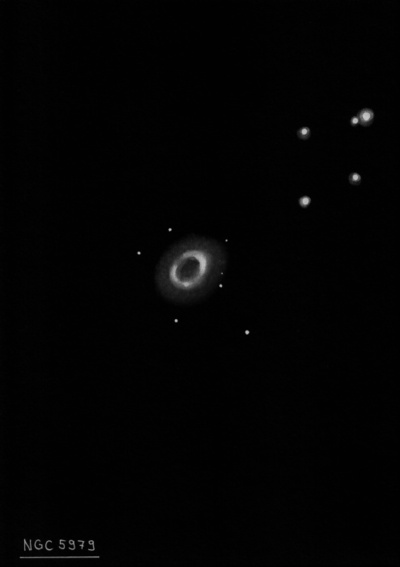
John Herschel discovered NGC 5979 = h3610 on 24 Apr 1835 and recorded "planetary nebula. Not B; pF; S; R; with something like a protuberance, which may arise from an accidental star, on or close to the edge. Not quite sharp; a little furred; light not quite uniform; an odd sort of mottling like a resolvable light; taken at first for a vF double star out of focus; 12" diameter; but seen with 240; 320 is too high a power for it. See figure 7, plate VI." On 16 Jun 1835, he recorded "planetary; transit just missed; R; 5" diam; about equal in light to a * 9m; of a feeble intensity of light; nearly equable; under 320 it is not nebulous; but indistinct at the edges; a very singular kind of appearance - not "mottled", not "curdled", but yet not planetary. In a field with about 100 or 150 stars. His position is accurate, but due to a reduction error the NGC position is 1.0 minute too far west (corrected in the IC 2 Notes section).
Joseph Turner sketched the planetary as annular and brighter or a thicker rim on the north side using the Great Melbourne Telescope (unpublished plate VII, figure 72).
400/500mm - 18" (7/7/02 - Magellan Observatory, Australia): at 171x and UHC filter, NGC 5979 appeared moderately bright, small, round. The disc was ~15" diameter and fairly evenly lit. It appeared larger than the catalogued size of 8". At 228x (unfiltered), the surface brightness was slightly irregular with possibly a very faint halo or the halo dims at the periphery. Set in a rich star field with a mag 10 star 2.7' S. A distinctive trail of mag 12-13 stars meanders off to the east. Located in the northwest corner of Triangulum Australe, about a degree from the Norma border.
Notes by Steve Gottlieb